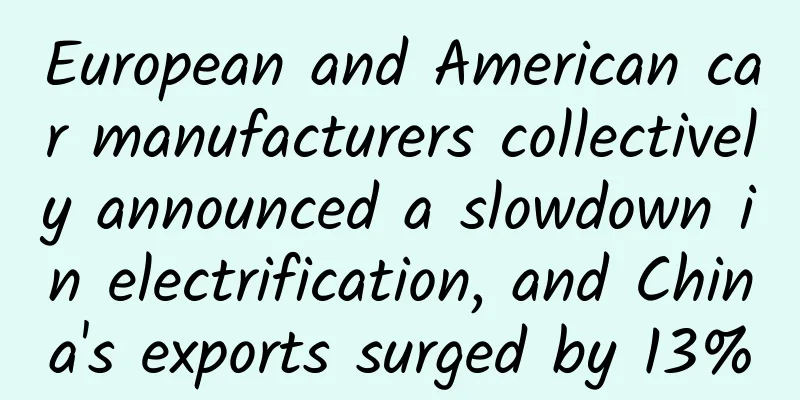European and American car manufacturers collectively announced a slowdown in electrification, and China's exports surged by 13%

|
Are we in S3? There are many different opinions on this issue, and it is difficult to say which one is correct. But one thing is certain: the differences between countries around the world are gradually widening. Taking the electric vehicle market as an example, China, the United States and the European Union are the three major players in the world, but there are obvious differences in their trends. According to the China Passenger Car Association, as of July 21, the cumulative wholesale sales of new energy passenger vehicles in China reached 5.057 million, a year-on-year increase of 28%. However, in many places outside China, the development speed is significantly lower than expected. Mainstream automakers have begun to slow down or even cancel their previous electrification goals, and the development process of new energy vehicles in China and abroad has shown obvious differentiation. Recently, General Motors said it would slow down its comprehensive electrification plan again, delaying the completion of its second US electric truck factory and the production of Buick electric vehicles. Previously, GM had set a goal of achieving a production capacity of 1 million electric vehicles in North America next year, but the delivery volume in the second quarter of this year was only 21,930 vehicles. Although it increased by 40% year-on-year, such results are really nothing compared with GM's ambitious plans. Before GM announced the delay in electrification, Ford also made a similar statement because its electric vehicle segment suffered a loss of $1 billion in the second quarter of this year alone, and the full-year loss is expected to exceed $5 billion, dragging down Ford's overall performance. As a representative of luxury brands and one of the most active manufacturers in developing electric vehicles, Porsche previously announced that it would abandon its established goal of "increasing the proportion of electric vehicle sales to 80% by 2030." Two years ago, Mercedes-Benz announced that it would basically transform its new car sales into electric vehicles by 2030. But in February this year, news of Mercedes-Benz's delay in electrification spread like wildfire. As for Toyota, another major auto giant, it did not believe in the trend of electrification from the beginning. Akio Toyoda has never stopped questioning electric vehicles. In addition to car companies, electric vehicle-related policies in many overseas countries and regions are also quietly changing. The most obvious is the United States, where the current electric vehicle support subsidy policy is likely to be cancelled after the election. As for the EU, news of its abandonment of carbon neutrality was reported as early as the end of last year. The electric vehicle plans of Europe and the United States were first promoted amid calls for environmental protection, and when the goal of carbon neutrality no longer exists, the electrification of the automotive industry does not seem to be so urgent. If car companies don't work hard and policies become loose or even regress, consumers' interest in electric vehicles will naturally decline. Since the second half of last year, the sales of electric vehicles in the European Union have been slowing down. In May this year, sales fell by 12% year-on-year, and the decline in Germany, a major automobile manufacturing country, reached 30%. In the US market, the penetration rate of new energy vehicles was only 18% in the first quarter of this year, while the figure was 18.8% in the fourth quarter of last year, marking the first decline in four years. In just three years, there have been clear differences between China, Europe, the United States and Japan in the development direction of the automotive industry. China is advancing by leaps and bounds, while Europe, the United States and Japan are slowing down or even regressing. The gap is visible to the naked eye. The main reason why major European, American and Japanese automobile manufacturers have changed their tune and slowed down their pace of electrification is that Chinese brands have risen too fast, beyond their expectations and control. Just like photovoltaic products, a rope that was originally used to restrict China's development, China took over this conspiracy and turned the rope around its neck into a deadly weapon like a nine-section whip. New energy vehicles were not first proposed by China. Europe, the United States, and Japan have already started to develop such products since the first oil crisis in the 1970s. Decades have passed, and their problem is still the same old problem - they are unable to launch their products at low cost. In the past few years, except for Tesla, almost all technological innovations in the field of new energy vehicles have come from Chinese manufacturers. Insufficient technical strength has made it difficult to create models that can satisfy consumers, and the prices of cars are also shockingly expensive. Although European and American manufacturers have set aggressive sales targets, they have been slow to act and iterate. For example, Volkswagen's MEB platform takes 48 months to develop a new car, and this is the most active manufacturer in the electrification transformation. The speed of other manufacturers can be imagined. The ability of Chinese manufacturers lies in turning overt schemes into boomerangs, hitting European and American car manufacturers one after another. So far, China's new energy vehicle sales have accounted for more than 60% of the global market share. On the technical level, whether it is smart cockpits, power batteries, smart driving, or other core components, China's new energy industry chain has everything, including complete vehicle champions such as BYD, as well as component giants such as Hesai and CATL. This constitutes a systemic advantage. China's new energy vehicle industry may make mistakes in some links, but its overall advantage is almost impossible to shake. More importantly, even if European and American countries impose tariffs on Chinese new energy vehicles, it is difficult to block Chinese manufacturers. This is firstly because China itself is the world's largest and most dynamic automobile market, and it can survive by relying on internal circulation. Secondly, countries and regions outside Europe and the United States do not reject Chinese new energy vehicles. In this case, slowing down the electrification process has become a safe way of transformation and a common choice for European and American automakers. This is not because "electric cars are a rip-off" or because they are far-sighted, but a rational choice based on realistic conditions and their own strengths. Faced with the collective shift in the development path of new energy in Europe and the United States, China's response was also very firm - in the first half of the year, China exported 605,000 new energy vehicles, a year-on-year increase of 13.2%. As a winner of Toutiao's Qingyun Plan and Baijiahao's Bai+ Plan, the 2019 Baidu Digital Author of the Year, the Baijiahao's Most Popular Author in the Technology Field, the 2019 Sogou Technology and Culture Author, and the 2021 Baijiahao Quarterly Influential Creator, he has won many awards, including the 2013 Sohu Best Industry Media Person, the 2015 China New Media Entrepreneurship Competition Beijing Third Place, the 2015 Guangmang Experience Award, the 2015 China New Media Entrepreneurship Competition Finals Third Place, and the 2018 Baidu Dynamic Annual Powerful Celebrity. |
<<: iPad Pro keyboard disassembly: Fully conductive, repairable
Recommend
Why did Oppenheimer become the leader of the Manhattan Project?
Popular Science Times reporter Chen Jie Nolan'...
Luo Zhenyu: From a media person to an entrepreneur, our 6 suggestions for content entrepreneurs
Luo Pang, who transformed from a media person int...
Two fates: Jack Ma and his rivals
There are not many people who have both good fort...
Gull-wing doors, king chairs, 5C supercharger, Haobo HT creates a luxurious mobile large flat for elite families
Hyper HT, a medium-to-large luxury pure electric ...
Why buy an iPhone 11 for the same price? After trying out the vivo NEX3, I realized that this is the phone of the future.
The mobile phone market is becoming increasingly ...
Nature released the "Top Ten Scientists of 2022", and Peking University's Cao Yunlong was on the list for "tracking the evolution of the new coronavirus"
Nature Cover The pictures and characters in this ...
What are the number ranges for 400 telephone numbers?
When enterprises are handling 400 telephone numbe...
Why did ocean oxidation take 2 billion years to complete? The key lies in this huge “reservoir” →
Oxygen is the source of life. The oxygen content ...
Apple releases iOS 13.3 / iPadOS 13.3 official version update
This morning, Apple released the official version...
A complete guide to online promotion methods!
1. External promotion As the name suggests, exter...
An American baby died after being infected with the new coronavirus. He was less than one year old!
On the 28th, the head of the Illinois State Publi...
Which month does the Return of the South Wind usually occur in 2022? How many days does it last?
The return of the south wind is a common phenomen...
Don't sleep, wake up! I'm hibernating
Have you noticed that after a large wave of rainf...
Dragon Head Secret Agent White Horse Secret Agent Zhong Zhan 27th Quantitative Science Dragon Catching Special Forces
Dragon Head Spy White Horse Spy Zhong Zhan 27th Q...
Apple eclipses Japanese electronics giant in solar eclipse
Japanese electronics giants such as Sony, Panason...









